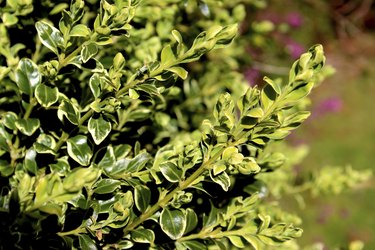
Many homeowners plant boxwood (Buxus spp.) when they want a hedge plant or a hardy, attractive specimen shrub. Boxwoods have dense, evergreen foliage that responds well to shaping. They are the classic hedge and topiary plant, and many species and cultivars even thrive in the shade.
If all that evergreen beauty goes yellow, however, the shrub's attractiveness diminishes greatly. There are several reasons that yellowing may occur, and some can be avoided with proper care.
Video of the Day
Video of the Day
Winter Desiccation / Winter Burn
Boxwoods prefer cool climates, with most species thriving in U.S. Department of Agriculture plant hardiness zones 4 through 8. But winter weather is one significant cause of yellowing leaves on boxwood plants, especially taller plants. Damage occurs when an unseasonably warm winter day gets the water flowing in the plant — water that quickly freezes when evening arrives. This damages the plant, and as a result, the leaves turn pale yellow.
The remedy is patience. Wait until all danger of frost is past; then use a sharp pruner to take off any branches that have split wood. If the entire shrub is damaged, cut it all the way back to between 12 and 18 inches above the ground. In many cases, the shrub will regrow.
Damaged or Dying Roots
A boxwood shrub struggles to survive if its roots are damaged. Damaged or dying roots are not able to absorb nutrients, and as a result, the leaves start to die, turning yellow and brown. Several things can damage boxwood roots, including soil nematodes and — most commonly — fungal diseases.
Once roots are damaged, the plant cannot be saved, but these problems are preventable with proper care. Overly wet soil is a haven for fungi, so plant your boxwood in a well-drained area in light, fertile soil. Avoid depressions where water tends to collect. Strong, healthy plants rarely get sick, so water deeply during periods of drought. Water stress can also cause yellowing leaves.
Boxwood Leafminer Damage
The boxwood leafminer is the most serious pest of boxwoods. The tiny orange flies that swarm the plant aren't so much the problem as the eggs they lay, because it's the tiny larvae that feast on the leaves. Leaves infested with leafminer larvae usually present with misshapen, yellow, or brown swollen spots and often drop from the plant. A severe infestation can defoliate and kill a boxwood.
Insecticides are not recommended unless the entire plant is severely affected. If you use an insecticide, use one that contains malathion and carbaryl. Apply the insecticide in mid-April or early May when you see the tiny adult flies. Instructions vary depending on the product, but in general, dilute 1 1/2 ounces in 1 gallon of water and fill a sprayer with this solution.